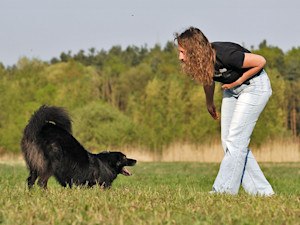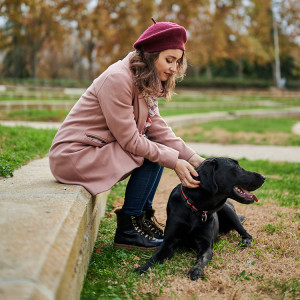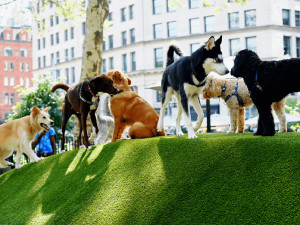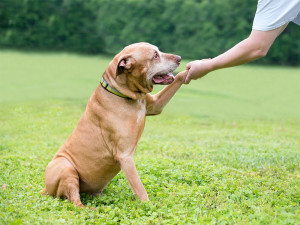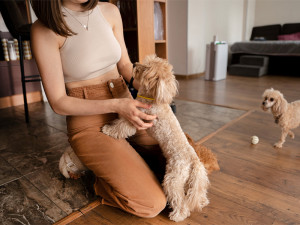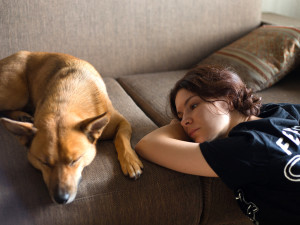What Does It Mean When Your Dog Bows?
No, it’s not always about getting in a good stretch.

Share Article
In This Article:
What the Dog Bow Looks Like Top 5 Reasons Your Dog Bows to You How to Respond When Your Dog Bows to You
You walk into the room, and your dog greets you with a pose straight out of a yoga class: front legs stretched forward, rump in the air, tail wagging like they just heard the dinner bell. You’ve been graced with the “dog bow.” Is it an elaborate stretch? A secret canine handshake? Or a way for your pup to tell you something profound and meaningful, like how much they love you?
In reality, this quirky, adorable move can be playful, it but could also indicate discomfort, like a stomach ache. Unraveling why a dog bows will help you understand other body language that a dog may use to express their feelings. It is not just an adorable pose. Here is some insight into what the bow could mean and how you should respond to it.
Main takeaways
A playful bow is a dog’s way of inviting you to have fun, often paired with a wagging tail and eager eyes.
Bowing can signal trust or submission, demonstrating that your dog respects and feels safe with you.
A less playful, rigid bow could indicate abdominal discomfort or pain, requiring veterinary attention.
Understanding the context of your dog’s bow allows you to respond appropriately, strengthening your bond and ensuring their wellbeing.
What does the dog bow look like?
A dog bow involves your pup lowering their front legs to the ground while keeping their hind legs straight and raised. There’s a reason the yoga pose is called “downward dog.”

Your dog’s tail may wag furiously in this position while their eyes gleam excitedly. It’s a call for attention, a powerful form of canine body language with different meanings depending on the context.
Dog bow vs. stretching: What’s the difference?
Some people think the dog bow is a fancy stretch, and they wouldn’t be entirely wrong. Dogs stretch all the time, especially when they’ve woken up from their umpteenth nap of the day. This is often called a “greeting stretch,” a casual way for pups to loosen their muscles after sleeping.
In contrast, a bow has more energy and intention. It’s a specific action used for communication, not a languid stretch. While a stretch is slow and leisurely, a bow is dynamic, sometimes energetic, and purposeful. It’s the difference between slouching on the couch and jumping up and down.
Top 5 reasons why your dog bows to you
1. Play bow
This is the original meaning of the dog bow. A “play bow” is your dog’s way of enticing you to have fun. Dogs may use this stance on humans and other dogs to gear up for games like fetch, tag, or zoomie sessions. The play bow is meant to hype up a playmate.
According to Dr. Alisha Kidwellopens in new tab, a veterinarian from North Carolina’s Cabarrus Animal Hospital, dogs who regularly engage in play bowing tend to have better social skills with humans and other dogs. Think of it as the canine equivalent of asking, “Wanna hang out?”
2. Submissiveness
Sometimes a bow can be a sign of submission. Your dog is conveying trust or expressing a peaceful intention. They are showing respect and acknowledging you as the leader of their pack (or the keeper of the kibble). This kind of bow is subdued, with soft eyes and a relaxed tail.
3. Mimicking exercise
Have you ever noticed your dog watching you stretch or exercise? Dogs are great at mimicking behaviors they see, especially if they get your attention. Your pup may not understand why you’re stretching or exercising, but they want to do it too — to make you laugh, smile, or pet them.
4. Greeting
When you come home after a long day out of the house, your dog’s bow could be a way of rolling out the proverbial red carpet. This bow is part of a happy greeting ritual, often paired with a wagging tail, a panting grin, and an excited bounce. They are genuinely delighted to see you.
5. Pain or discomfort
Not all bows are playful. Sometimes, a dog assumes a bow-like posture to relieve pain, especially in the abdomen, because a bow will stretch the abdominal muscles. This bow is called the “prayer position,” indicating bloating, digestive issues, or other uncomfortable medical mishaps. If your dog frequently bows without playful energy, consult a veterinarian.
How to respond when your dog bows to you
Your response to a dog bowing to you depends on the situation and their body language.
When a dog bow is playful: Grab a toy, get on their level, and join the fun. Play fetch, tug-of-war, or chase them around the yard or house. Indulging their playful bow strengthens your bond, and gives them the mental and physical stimulation to release energy and fortify good health.
When a dog bow is submissive: Offer calm reassurance with a gentle pat and soft voice. Let them know they are in a safe, loving place.
When a dog bow is mimicking: Encourage their adorable behavior with a smile, eye contact, and petting.
When a dog bow is a greeting: Show them affection and love. Your dog lives for the moment you walk through the door, so make it memorable.
When a dog bow indicates pain or discomfort: Pay attention. Contact a veterinarian if their bow seems unusual or is paired with signs of distress, like lethargy or whining.
Bottom line
Sometimes, a dog’s bow can be like a love letter to you, using body language to convey devotion. The gesture can be playful, adorable, and charming, enticing you to play and show affection and trust.
When you understand the context of a dog’s bow, you can respond appropriately, strengthening the bond between yourself and your dog. Understanding their intentions makes your pup feel valued and loved.
The next time your dog bows with positive body language, such as an excited, wagging tail and affectionate, playful eyes, think of it as them saying that you are their favorite human, and they love you.
FAQs
Why does my dog bow when I approach them?
If your dog bows upon approach, they are inviting you to play with them or show excitement. Their body language involves excited eyes and a wagging tail.
Why do dogs bow when they greet you?
You are your dog’s best friend. They live for your attention. When a dog bows as a greeting, they are saying “hello” and telling you how happy they are to see you.
What does it mean when a dog bows their head to you?
This could be a sign of submission, affection, or a request for attention, like a pat on the head. Always consider the context and body language to understand the message.
References
“What Does It Mean When Your Dog Bows – [Vet Explains Pets].” Vetexplainspets.com, 2024, vetexplainspets.com/what-does-it-mean-when-your-dog-bowsopens in new tab. Accessed 30 Dec. 2024.
“The Dog Alliance.” The Dog Alliance, 27 Oct. 2024, thedogalliance.org/why-does-my-dog-bowopens in new tab. Accessed 30 Dec. 2024.

Valerie Mellema
Valerie Mellema has a Bachelor of Science in Agribusiness and Equine Industry from West Texas A&M University. She has been a professional writer for the past 20 years, covering a wide variety of pet health and care topics before founding a nonprofit focused on mental health in children and thoroughbred aftercare. She has four Border Collies and eight retired racehorses.
Related articles
![dogs at dog park drinking water and playing in pool]()
Dog Park Etiquette: Dog Park Dos and Don’ts
New kid on the block? Follow this trainer’s tips before letting your pet run wild.
![A senior Retriever/Terrier mixed breed dog shaking hands with its owner.]()
How to Teach an Old Dog New Tricks
Your senior dog might move slower these days, but that doesn’t mean they can’t learn new things.
Can Dogs Communicate With Each Other?
It’s about more than barking.
![A woman sitting on a floor playing with her dogs.]()
How to Know if Your Dog Has Imprinted on You
If they’re following you around like your shadow, there’s a reason for that.
Does My Dog Love Me? How to Interpret Canine Bonding Behavior
What to do when you don’t feel the close bond you want.
![Woman walking her dog in a park]()
Dog Walking 101: How Often Should You Walk Your Dog?
And why you shouldn’t skip the longer routes.

